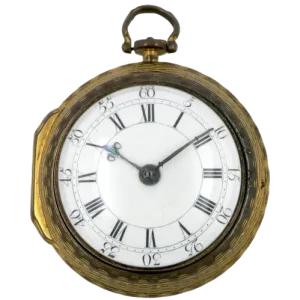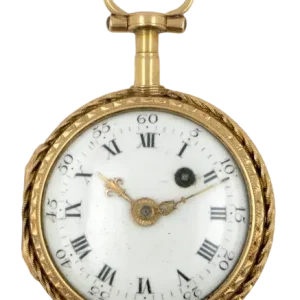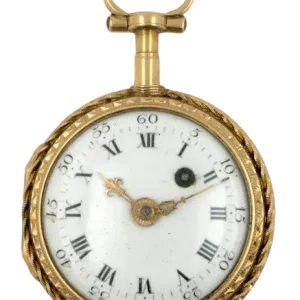Collecting antique pocket watches is a fascinating endeavor that combines history, craftsmanship, and personal passion. As wearable pieces of art, these timepieces not only serve as functional instruments for measuring time but also embody the intricate artistry and engineering skills of their eras. From the ornate designs of the 18th century to the precise mechanics of the Victorian age, each pocket watch tells a unique story, reflecting the technological advancements and aesthetic sensibilities of its time. This guide aims to provide aspiring collectors with valuable insights into the world of antique pocket watches, covering essential topics such as identifying reputable sources, understanding key terminology, and recognizing the significance of various styles and movements. Whether you are a novice eager to embark on your collecting journey or an experienced enthusiast seeking to refine your knowledge, this comprehensive resource will equip you with the tools needed to navigate auctions, assess the condition of timepieces, and appreciate the rich heritage that these remarkable objects represent. Join us as we delve into the captivating realm of antique pocket watches, exploring the factors that contribute to their value and the joy they can bring to collectors and aficionados alike.
Understanding the history of pocket watches.

The evolution of pocket watches is a fascinating journey that reflects advancements in technology, craftsmanship, and societal trends. Originating in the late 15th century, these timepieces were initially bulky, often crafted from iron and housed in ornate cases. As the demand for portable timekeeping devices grew, the design and mechanics of pocket watches underwent significant refinement. The introduction of the mainspring in the early 16th century marked a pivotal moment, allowing for more compact designs and improved accuracy. By the 17th century, innovations such as the balance wheel and escapement mechanism contributed to the reliability of these watches, setting the stage for their prominence in the following centuries.
Throughout the 18th and 19th centuries, pocket watches became symbols of status and sophistication, reflecting the tastes and values of their owners. The Industrial Revolution played a crucial role in their proliferation, as mass production techniques made watches more accessible to the burgeoning middle class. This period saw the rise of renowned watchmakers and brands, each striving to outdo one another in craftsmanship and innovation. By the late 19th century, pocket watches had reached their zenith, with intricate designs and elaborate features captivating enthusiasts. Their decline in popularity began with the advent of wristwatches in the early 20th century, yet pocket watches remain a revered collectible, appreciated for their artistry and historical significance.
Identifying key features of antiques.

When evaluating pocket watches, several key features must be examined to assess their authenticity and value. The first critical aspect is the craftsmanship, which can be discerned by inspecting the materials used in construction, the quality of the finish, and the intricate details of the engravings. Genuine antique pocket watches often showcase superior workmanship, with hand-finished components that exhibit a level of artistry and precision not commonly found in contemporary reproductions.
Additionally, the movement of the watch serves as a vital indicator of its age and authenticity. Collectors should familiarize themselves with the various styles of movements, such as key-wind or stem-wind mechanisms, as well as the signature markings or hallmarks that signify reputable makers. The watch’s case, whether made from gold, silver, or base metals, also contributes to its overall significance, and understanding the historical context of these materials can provide insight into the watch’s provenance. Collectors should take care to document the condition and any modifications, as these factors can heavily influence the watch’s value and desirability within the antique market.
Researching reputable antique watch dealers.

Due diligence is essential when selecting a dealer for antique watches, as the market can be rife with reproductions and misrepresented items. Start by seeking out dealers with established reputations, evidenced by their longevity in the industry and positive testimonials from past clients. Associations with recognized organizations, such as the National Association of Watch and Clock Collectors, or participation in reputable antique shows can further validate a dealer’s credibility. Engaging with fellow collectors through forums or local clubs can also yield valuable recommendations, helping you connect with trustworthy dealers.
In addition to personal experiences, an assessment of the dealer’s inventory can provide insight into their expertise and focus. A reputable dealer will be transparent about the provenance of their watches and should readily provide detailed information about each piece, including its history and any restoration work performed. It is also prudent to inquire about the dealer’s return policy and guarantees regarding authenticity, which are crucial safeguards for collectors. By taking the time to conduct thorough research and establish a rapport with reputable dealers, collectors can confidently navigate the intricate world of antique timepieces.
Evaluating pocket watch condition and authenticity.

Critical to the appraisal of antique pocket watches is the careful examination of their condition and authenticity. Begin by inspecting the case for signs of wear such as scratches, dents, or corrosion. A well-preserved case can indicate a watch that has been cared for over time, while excessive damage may suggest a lack of maintenance or improper handling. Additionally, the watch’s movement should be scrutinized; authentic pieces often feature intricate craftsmanship, with markings that are consistent with the manufacturer’s style and era. Look for serial numbers, hallmarks, and maker’s marks, which can offer insights into both the watch’s age and authenticity.
Verifying authenticity also requires an understanding of the specific characteristics that define various brands and models. Knowledge of the typical materials used in the casing, the design of the dials, and the configuration of the movements can significantly assist in distinguishing genuine articles from counterfeits. When possible, consult reference books or databases that catalog known examples of specific models, as these resources can provide a benchmark for comparison. Engaging a professional watchmaker or appraiser for a thorough evaluation can further enhance your confidence in the purchase, protecting you from the pitfalls of the market.
Learning common pocket watch brands.
Familiarity with prominent brands such as Patek Philippe, Vacheron Constantin, and Audemars Piguet can enhance one’s ability to identify features unique to each manufacturer. For instance, Patek Philippe watches are known for their intricate complications and high-quality movements, while Vacheron Constantin often showcases exceptional craftsmanship with ornate dials. Understanding these nuances not only aids in authenticating a timepiece but also enriches the collector’s appreciation of the history and artistry encapsulated in each watch.
In addition to the renowned luxury brands, there are several noteworthy American manufacturers, including Waltham and Elgin, which played significant roles in the development of pocket watches during the 19th and early 20th centuries. These brands are characterized by their robust constructions and reliable movements, often appealing to collectors for their historical significance and accessibility. By studying the distinguishing features of these common pocket watch brands, collectors can develop a critical eye, making informed decisions that enhance their collections and deepen their engagement with the horological world.
Determining value and pricing factors.
Assessing the value of antique pocket watches requires careful consideration of various pricing factors. The rarity of a specific model plays a crucial role; limited production runs or unique features can significantly elevate a watch’s desirability among collectors. Additionally, the condition of the timepiece is paramount, as signs of wear, restoration, or damage can impact its market value. Originality is also a critical factor; any alterations or replacement parts may diminish the watch’s appeal to purists who highly value authenticity.
Provenance and historical significance can further influence pricing, with pieces linked to notable figures or significant events often commanding premium prices. Market trends and demand within the collector community also fluctuate, making it essential for collectors to stay informed about current valuations and recent sales of similar models. By synthesizing these elements—rarity, condition, originality, provenance, and market dynamics—collectors can make informed decisions when determining the value of antique pocket watches.
Properly maintaining and caring for watches.
To ensure the longevity and functionality of a watch, it is essential to adhere to a consistent maintenance routine. Regular servicing by a qualified professional is recommended, typically every three to five years, to address any mechanical issues, clean the movement, and replace worn parts. This proactive approach not only preserves the watch’s performance but also helps maintain its value over time. In addition, keeping the watch clean and free from dust or moisture can prevent damage to both the case and the movement, while using appropriate storage solutions—such as watch boxes with anti-magnetic properties—can further safeguard against environmental hazards.
Caring for a watch also entails being mindful of its daily wear. Avoid exposing the timepiece to extreme temperatures, magnetic fields, or harsh chemicals, as these can adversely affect its mechanics and aesthetics. Regularly checking the water resistance and ensuring that the crown is securely closed when not in use are crucial practices, particularly for models designed for aquatic activities. By taking these careful steps, collectors can ensure their antique pocket watches remain cherished pieces that tell time and uphold their historical significance.
Joining pocket watch collector communities.
Participating in pocket watch collector communities offers valuable opportunities for enthusiasts to connect, share knowledge, and expand their collections. These communities, whether online forums or local clubs, foster an environment where collectors can exchange insights about market trends, restoration techniques, and historical context. Engaging with like-minded individuals enables collectors to deepen their understanding of various brands and models, as well as the intricacies of pocket watch mechanics. This collaborative atmosphere not only enhances individual appreciation for the craft but also encourages members to showcase their own collections, sparking inspiration and enthusiasm among peers.
Moreover, involvement in these communities can lead to access to exclusive events, such as auctions, exhibitions, and workshops led by experts in horology. Such gatherings not only provide platforms for acquiring rare timepieces but also facilitate mentorship opportunities, where seasoned collectors can offer guidance to newcomers. The exchange of experiences and stories within these groups enriches the collecting journey, creating lasting connections and a sense of belonging that transcends mere acquisition of timepieces.
Attending antique shows and auctions.
Exploring antique shows and auctions serves as a vital avenue for collectors to discover unique and often rare pocket watches that may not be available through conventional retail channels. These events attract a diverse array of sellers, from private collectors looking to downsize to dealers specializing in vintage timepieces. The atmosphere is charged with enthusiasm, providing collectors the opportunity to inspect watches closely, assess their condition, and gauge market value firsthand. Knowledgeable bidders often come prepared with research to make informed decisions, ensuring that they are both prudent and passionate in their acquisitions.
Furthermore, auctions can unveil unexpected treasures, as sometimes items are sold at prices below their market potential due to lackluster bidding or misjudged value by previous owners. This unpredictability can lead to excellent finds for those who are well-versed in pocket watch history and mechanics, allowing astute collectors to enhance their collections significantly. Ultimately, attending these events not only enriches personal collections but also deepens a collector’s appreciation for the artistry and craftsmanship that define antique pocket watches.
In conclusion, collecting antique pocket watches can be a rewarding and enriching hobby for enthusiasts and novices alike. With their intricate craftsmanship and historical significance, these timepieces offer a unique glimpse into the past. As you embark on your collecting journey, remember to focus on authenticity, provenance, and the personal stories behind each watch. Building a knowledgeable network of fellow collectors and experts can also enhance your experience and provide valuable insights. Whether you are drawn to the artistry, engineering, or nostalgia of pocket watches, this guide serves as a foundation for your exploration, encouraging you to appreciate the timeless elegance and heritage that each piece embodies. Happy collecting!






Sunday, 14 December , 2025